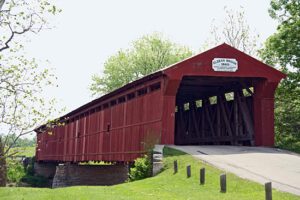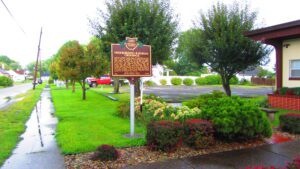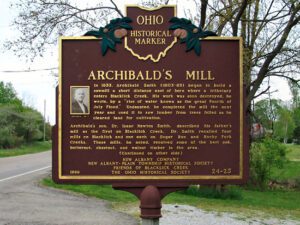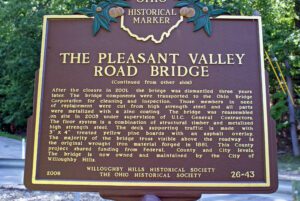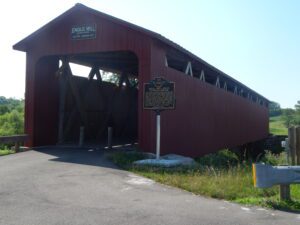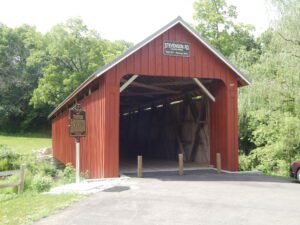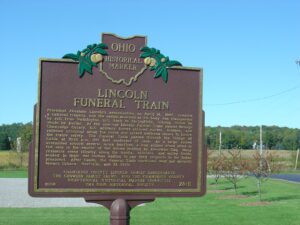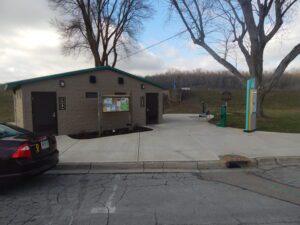, OH
Originally known as Allen’s Mill Bridge, the Eldean Covered Bridge was built over the Great Miami River in 1860 for Miami County by the Hamilton Brothers of nearby Piqua. Its 224 feet place it among Ohio’s longest covered bridges and the longest in the nation that follows an 1830 Stephen H. Long patent, considered America’s first science-based bridge design. The Long system added strength through a series of hand-driven wedges. Placed on the National Register of Historic Places in 1975, the bridge was restored in 2005/2006.
, OH
Underground Railroad crossings, agents, and conductors were common along the Ohio River between Washington County, Ohio and Wood County, Virginia. At Constitution, six miles upriver from Belpre, Judge Ephraim Cutler listened for hoot owl calls that signaled when a boatload of runaway slaves was crossing from Virginia to the Ohio shore. “Aunt Jenny,” a slave woman in Virginia, used a horn signal to alert abolitionist John Stone in Belpre when fugitive slaves were crossing. At Little Hocking, eight miles downriver from Belpre, slaves crossing from Virginia looked for a lantern signal to guide them to the Horace Curtis Station on the Ohio River shore. Runaway slaves were also assisted by Thomas Vickers at Twin Bridges, James Lawton at Barlow, and others as they traveled northward by various routes through Morgan County to Putnam in Muskingum County where the Underground Railroad merged with the Muskingum River Corridor.
, OH
In 1833, Archibald Smith (1803-83) began to build a sawmill a short distance east of here where a tributary enters Blacklick Creek. His work was soon destroyed, he wrote, by a “rise of water known as the great Fourth of July Flood.” Undaunted, he completed the mill the next year and used it to saw lumber from trees felled as he cleared land for cultivation. Archibald’s son, Dr. Isaac Newton Smith, described his father’s mill as the first on Blacklick Creek. Dr. Smith recalled four mills on Blacklick and one each on Sugar Run and Rocky Fork Creeks. These mills, he noted, received some of the best oak, butternut, chestnut, and walnut timber in the area. (Continued on other side)
, OH
This single lane Pleasant Valley Road Bridge was constructed in 1881 by the Wrought Iron Bridge Company of Canton, Ohio, and is a 163 foot-long Whipple Truss (double intersection Pratt through truss). It replaced a wooden bridge that portaged the west branch of the Chagrin River a few hundred yards downstream. The structure, one of less than ten of its kind remaining in the state of Ohio, and possibly the longest in Lake County, was built to sustain the Euclid-Chardon Road traffic on U.S. Route 6. Known as the Grand Army of the Republic Highway, G.A.R., this major thoroughfare served this purpose until 1952 when a new high level bridge bypass was constructed to the south. The Truss bridge, pleasing to the eye with the artwork and name plates atop the overhead portals, was designed to enhance the bridge’s appearance within the valley. (Continued on other side)
, OH
Built in 1877 and spanning 136 feet, the Engle Mill Road Covered Bridge carried vehicular traffic until 2003. The bridge is named after the nearby Levi Engle Mill. It is one of a few dozen Smith Truss bridges in the United States. The Smith Bridge Company manufactured the bridge using the Smith Truss patent, invented by founder, Robert W. Smith. The company originated in Tippecanoe City, Ohio and relocated to Toledo, where it was purchased by the Toledo Bridge Company in 1890. Smith died in 1898 at the age of 63, leaving a legacy of unique bridges.
, OH
Built in 1877 and spanning approximately ninety-five feet, the Stevenson Road Covered Bridge carried vehicular traffic until 2003. It is one of the few Smith truss bridges left in the United States. The Smith Bridge Company manufactured the bridge using various patents of the company, which were secured by its founder, Robert W. Smith. The company originated in Tippecanoe City, Ohio (Tipp City) and later relocated to Toledo. In 1890 the Toledo Bridge Company Purchased the company from Smith. Robert Smith died in 1898 at the age of sixty-five leaving behind a legacy of unique covered bridges.
, OH
President Abraham Lincoln’s assassination on April 14, 1865, created a national tragedy, and the nation mourned as his body was transported by rail from Washington, D.C. back to Springfield, Illinois, where he would be buried. As the nine-car Lincoln Funeral Train passed through Champaign County, U.S. military forces secured curves, bridges, and railroad crossings along the route and spiked switches closed to insure the train’s safety. The Funeral Train passed through the Village of Cable at 10:13 p.m. 150 feet southeast of here. As a large crowd assembled around several large bonfires, a lone soldier stood alone in the rain in the center of the crowd holding an American flag. Many residents stood silently along the tracks, hillsides, and valley fields, soaked in their wet clothes waiting to pay their respects to the fallen president. After Cable, the Funeral Train continued west and downhill toward Urbana, Westville, and St. Paris.
, OH
In late March 1913, a series of three severe rainstorms inundated the already saturated and frozen ground of the Miami Valley, causing one of Ohio’s greatest natural disasters, the Flood of 1913. On March 25, the Great Miami River overflowed its banks at Miamisburg, fed by runoff from Bear and Sycamore creeks. Homes, businesses, and the bridges at Linden Avenue and Sycamore Street were swept away or wrecked by floodwaters reaching as high as eleven feet on Main and First streets. Early reports indicated that six people in the area died. Cleanup and recovery efforts took approximately a year. (Continued on other side)


